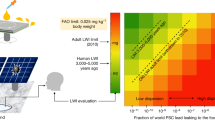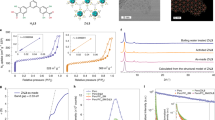Abstract
As the market uptake of perovskite solar cells (PSCs) is projected to grow rapidly, this clean energy technology will play an increasingly important role in reducing the global carbon footprint. However, one of the major barriers to its full commercialization is the presence of toxic lead (Pb), which enables the current record in photoconversion efficiency but risks being released into the environment when subjected to water or rain. Here we show that Pb leakage can be prevented by applying a transparent titanium dioxide (TiO2) sponge that allows for an efficient Pb sequestration of 58 ng cm−2 nm−1. Already an essential material for PSCs, the additional use of TiO2 through a scalable and solvent-free sputtering process promises extra cost benefits and higher sustainability. Further demonstration of the sponge application with desired thickness on ready-to-use devices, glass and polymeric foils enforces the practical value of the current approach. Our study provides a sustainable solution to one of the environmental and health risks of PSCs and would accelerate their practical applications.
This is a preview of subscription content, access via your institution
Access options
Access Nature and 54 other Nature Portfolio journals
Get Nature+, our best-value online-access subscription
$29.99 / 30 days
cancel any time
Subscribe to this journal
Receive 12 digital issues and online access to articles
$119.00 per year
only $9.92 per issue
Buy this article
- Purchase on Springer Link
- Instant access to full article PDF
Prices may be subject to local taxes which are calculated during checkout





Similar content being viewed by others
Data availability
The data supporting the findings of this study are available within this paper and the Supplementary Information. Source data are provided with this paper.
References
Min, H. et al. Perovskite solar cells with atomically coherent interlayers on SnO2 electrodes. Nature 598, 444–450 (2021).
Jena, A. K., Kulkarni, A. & Miyasaka, T. Halide perovskite photovoltaics: background, status, and future prospects. Chem. Rev. 119, 3036–3103 (2019).
Rong, Y. et al. Challenges for commercializing perovskite solar cells. Science 361, eaat8235 (2018).
Mathews, I. et al. Economically sustainable growth of perovskite photovoltaics manufacturing. Joule 4, 822–839 (2020).
Khenkin, M. V. et al. Consensus statement for stability assessment and reporting for perovskite photovoltaics based on ISOS procedures. Nat. Energy 5, 35–49 (2020).
Reddy, S. H., Di Giacomo, F. & Di Carlo, A. Low-temperature-processed stable perovskite solar cells and modules: a comprehensive review. Adv. Energy Mater. 12, 2103534 (2022).
Li, J. et al. Biological impact of lead from halide perovskites reveals the risk of introducing a safe threshold. Nat. Commun. 11, 310 (2020).
Ponti, C. et al. Environmental lead exposure from halide perovskites in solar cells. Trends Ecol. Evol. 37, 281–283 (2022).
Gorjian, S. et al. Progress and challenges of crop production and electricity generation in agrivoltaic systems using semi-transparent photovoltaic technology. Renew. Sust. Energ. Rev. 158, 112126 (2022).
Koh, T. M. et al. Halide perovskite solar cells for building integrated photovoltaics: transforming building façades into power generators. Adv. Mater. 34, 2104661 (2022).
Pitaro, M., Tekelenburg, E. K., Shao, S. & Loi, M. A. Tin halide perovskites: from fundamental properties to solar cells. Adv. Mater. 34, 2105844 (2022).
Jiang, X. et al. One-step synthesis of SnI2·(DMSO)x adducts for high-performance tin perovskite solar cells. J. Am. Chem. Soc. 143, 10970–10976 (2021).
Sanchez-Diaz, J. et al. Tin perovskite solar cells with >1,300 h of operational stability in N2 through a synergistic chemical engineering approach. Joule 6, 861–883 (2022).
Jiang, Y. et al. Reduction of lead leakage from damaged lead halide perovskite solar modules using self-healing polymer-based encapsulation. Nat. Energy 4, 585–593 (2019).
Ravi, V. K., Mondal, B., Nawale, V. V. & Nag, A. Don’t let the lead out: new material chemistry approaches for sustainable lead halide perovskite solar cells. ACS Omega 5, 29631–29641 (2020).
Li, X. et al. On-device lead sequestration for perovskite solar cells. Nature 578, 555–558 (2020).
Chen, S. et al. Trapping lead in perovskite solar modules with abundant and low-cost cation exchange resins. Nat. Energy 5, 1003–1011 (2020).
Chen, S. et al. Preventing lead leakage with built-in resin layers for sustainable perovskite solar cells. Nat. Sustain. 4, 636–643 (2021).
Lee, J., Kim, G.-W., Kim, M., Park, S. A. & Park, T. Nonaromatic green-solvent-processable, dopant-free, and lead-capturable hole transport polymers in perovskite solar cells with high efficiency. Adv. Energy Mater. 10, 1902662 (2020).
Li, X. et al. On-device lead-absorbing tapes for sustainable perovskite solar cells. Nat. Sustain. 4, 1038–1041 (2021).
Clarke, C. J., Tu, W., Levers, O., Bröhl, A. & Hallett, J. P. Green and sustainable solvents in chemical processes. Chem. Rev. 118, 747–800 (2018).
Albini, A., Protti, S. in Paradigms in Green Chemistry and Technology 77–85 (Springer, 2016).
Chea, J. D. Evaluation of solvent recovery options for economic feasibility through a superstructure-based optimization framework. Ind. Eng. Chem. Res. 59, 5931–5944 (2020).
Giammar, D. E., Maus, C. J. & Xie, L. Effects of particle size and crystalline phase on lead adsorption to titanium dioxide nanoparticles. Environ. Eng. Sci. 24, 85–95 (2007).
Zhao, X., Jia, Q., Song, N., Zhou, W. & Li, Y. Adsorption of Pb(II) from an aqueous solution by titanium dioxide/carbon nanotube nanocomposites: kinetics, thermodynamics, and isotherms. J. Chem. Eng. Data 55, 4428–4433 (2010).
Liang, P., Qin, Y. C., Hu, B., Peng, T. Y. & Jiang, Z. C. Nanometer-size titanium dioxide microcolumn on-line preconcentration of trace metals and their determination by inductively coupled plasma atomic emission spectrometry in water. Anal. Chim. Acta 440, 207–213 (2001).
Lee, S. & Park, S. TiO2 photocatalyst for water treatment applications. J. Ind. Eng. Chem. 19, 1761–1769 (2013).
Jacobsson, T. J. et al. An open-access database and analysis tool for perovskite solar cells based on the FAIR data principles. Nat. Energy 7, 107–115 (2022).
Kim, M. et al. Conformal quantum dot–SnO2 layers as electron transporters for efficient perovskite solar cells. Science 375, 302–306 (2022).
Seo, S. et al. Amorphous TiO2 coatings stabilize perovskite solar cells. ACS Energy Lett. 6, 3332–3341 (2021).
Alberti, A. et al. Nanostructured TiO2 grown by low-temperature reactive sputtering for planar perovskite solar cells. ACS Appl. Energy Mater. 2, 6218–6229 (2019).
Sanzaro, S. et al. Multi-scale-porosity TiO2 scaffolds grown by innovative sputtering methods for high throughput hybrid photovoltaics. Sci. Rep. 6, 39509 (2016).
Alberti, A. et al. Innovative spongy TiO2 layers for gas detection at low working temperature. Sens. Actuators B 259, 658–667 (2018).
Bisconti, F. et al. Managing transparency through polymer/perovskite blending: a route toward thermostable and highly efficient, semi-transparent solar cells. Nano Energy 89, 106406 (2021).
Giuliano, G., Bonasera, A., Arrabito, G. & Pignataro, B. Semitransparent perovskite solar cells for building integration and tandem photovoltaics: design strategies and challenges. Sol. RRL 5, 2100702 (2021).
Diebold, U. The surface science of titanium dioxide. Surf. Sci. Rep. 48, 53–229 (2003).
Park, S. Y. & Zhu, K. Advances in SnO2 for efficient and stable n–i–p perovskite solar cells. Adv. Mater. 34, 2110438 (2022).
Smecca, E. et al. Porous gig-lox TiO2 doped with N2 at room temperature for P-type response to ethanol. Chemosensors 7, 1–12 (2019).
Sanzaro, S. et al. Pervasive infiltration and multi-branch chemisorption of N-719 molecules into newly designed spongy TiO2 layers deposited by gig-lox sputtering processes. J. Mater. Chem. A 5, 25529–25538 (2017).
Sanzaro, S. et al. Bimodal porosity and stability of a TiO2 gig-lox sponge infiltrated with methyl-ammonium lead iodide perovskite. Nanomaterials 9, 1300 (2019).
Alberti, A. et al. MOx-based gas sensor and manufacturing method thereof. US patent 10871462B2 (2020).
Ratcliff, L. E. et al. Flexibilities of wavelets as a computational basis set for large-scale electronic structure calculations. J. Chem. Phys. 152, 194110 (2020).
MaX Centre of Excellence Project. BigDFT software package http://www.bigdft.org (2005).
Goedecker, S., Teter, M. & Hutter, J. Separable dual-space Gaussian pseudopotentials. Phys. Rev. B 54, 1703–1710 (1996).
Willand, A. et al. Conserving pseudopotentials with chemical accuracy compared to all-electron calculations. J. Chem. Phys. 138, 104109 (2013).
Marques, M. A., Oliveira, M. J. & Burnus, T. Libxc: a library of exchange and correlation functionals for density functional theory. Comput. Phys. Comm. 183, 2272–2281 (2012).
Reddy, K. M., Manorama, S. V. & Reddy, A. R. Bandgap studies on anatase titanium dioxide nanoparticles. Mater. Chem. Phys. 78, 239–245 (2003).
Fisicaro, G. et al. Wet environment effects for ethanol and water adsorption on anatase TiO2 (101) surfaces. J. Phys. Chem. C. 124, 2406–2419 (2020).
Fisicaro, G., Genovese, L., Andreussi, O., Marzari, N. & Goedecker, S. A generalized Poisson and Poisson–Boltzmann solver for electrostatic environments. J. Chem. Phys. 144, 014103 (2016).
Fisicaro, G. et al. Soft-sphere continuum solvation in electronic-structure calculations. J. Chem. Theory Comput. 13, 3829–3845 (2017).
Andreussi, O. & Fisicaro, G. Continuum embeddings in condensed-matter simulations. Int. J. Quantum Chem. 119, e25725 (2019).
Buckley, F. & Maryott, A.A. Tables of Dielectric Dispersion Data for Pure Liquids and Dilute Solutions (US Dept. of Commerce, National Bureau of Standards, 1958).
Wei, H. & Huang, J. Halide lead perovskites for ionizing radiation detection. Nat. Commun. 10, 1066 (2019).
Acknowledgements
This activity was partially supported at National Research Council (CNR) by the national projects, BEYOND NANO Upgrade (Univocal Project Code (CUP) G66J17000350007) and VertiGrow (CUP B15F21004410005). This work has been partially funded by the European Union (NextGeneration EU), through the MUR-PNRR project SAMOTHRACE – Sicilian MicronanoTech Research and Innovation Center (ECS00000022, CUP B63C22000620005). This work was supported by a grant from the Swiss National Supercomputing Centre (CSCS) under project ID s963 and s1167. We thank T. Quinn for her kind proofreading work. We also thank V. Privitera (CNR-IMM) for supporting this research.
Author information
Authors and Affiliations
Contributions
S.V. conceived the idea of the experiment, coordinated data analyses and cross-correlations and wrote the paper; E.S. and V.A performed X-ray reflectivity measurements; C.B. carried out STEM and energy dispersive X-ray analyses, under the supervision of C. Spinella; S.D., A.S. and S.C. conducted Pb sequestration measurements; F.B. and A.R. fabricated perovskite solar cells; G.M and C. Spampinato performed spectroscopic ellipsometry measurements; G.F., I.D. and S.G. carried out DFT calculations; E.F. and F.N. performed X-ray photoelectron spectroscopy analysis; A.L.M. supervised the research. A.A. planned and coordinated the experiments, data analyses, collaborations and funding. All authors reviewed the paper.
Corresponding author
Ethics declarations
Competing interests
The authors declare no competing interests.
Peer review
Peer review information
: Nature Sustainability thanks Shangshang Chen and the other, anonymous, reviewer(s) for their contribution to the peer review of this work.
Additional information
Publisher’s note Springer Nature remains neutral with regard to jurisdictional claims in published maps and institutional affiliations.
Supplementary information
Supplementary Information
Supplementary Figs. 1–14, Tables 1–6 and Notes 1–6.
Supplementary Data
Data of forward-scan current density–voltage curve in Supplementary Fig. 1.
Supplementary Data
Data of photovoltaic parameters over time in Supplementary Fig. 2.
Supplementary Data
Data of transmittance vs photon energy in Supplementary Fig. 3.
Supplementary Data
Data of absorption coefficient and transmittance vs photon energy in Supplementary Fig. 7a,b.
Supplementary Data
Data of absorption coefficient vs photon energy in Supplementary Fig. 14.
Source data
Source Data Fig. 1
Data of reverse-scan current density–voltage curve in Fig. 1f.
Source Data Fig. 2
Data of Pb concentration vs time and Pb-adsorption capability vs TiO2 thickness in Fig. 2b,c.
Source Data Fig. 4
Data of energy dispersive X-ray graph in Fig. 4f.
Source Data Fig. 5
Data of Kohn–Sham total energy in Fig. 5e,f.
Rights and permissions
Springer Nature or its licensor (e.g. a society or other partner) holds exclusive rights to this article under a publishing agreement with the author(s) or other rightsholder(s); author self-archiving of the accepted manuscript version of this article is solely governed by the terms of such publishing agreement and applicable law.
About this article
Cite this article
Valastro, S., Smecca, E., Mannino, G. et al. Preventing lead leakage in perovskite solar cells with a sustainable titanium dioxide sponge. Nat Sustain 6, 974–983 (2023). https://doi.org/10.1038/s41893-023-01120-w
Received:
Accepted:
Published:
Issue Date:
DOI: https://doi.org/10.1038/s41893-023-01120-w
This article is cited by
-
Shedding light on the environmental impact of the decomposition of perovskite solar cell
Scientific Reports (2023)
-
Preventing lead release from perovskites
Nature Sustainability (2023)



